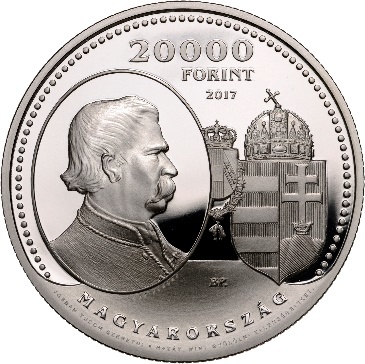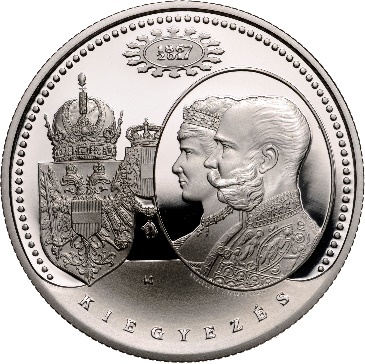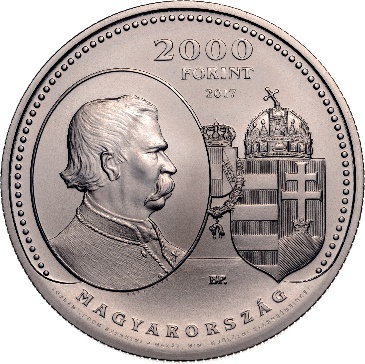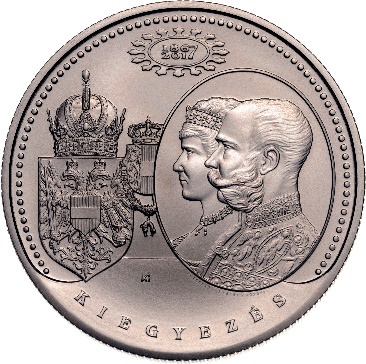Budapest, 29 May 2017 – The Magyar Nemzeti Bank will issue a silver commemorative coin with a face value of HUF 20,000 and a HUF 2,000, non-ferrous metal version thereof on 29 May 2017 on the 150th anniversary of Austro-Hungarian Compromise. With their diameter of 52.5 mm the commemorative coins are especially big of size, their inner, fold-back edge is the result of a new design.
|
150 years ago, on 29 May 1867 the Hungarian Parliament voted for Article XII on the Austro-Hungarian Compromise, which established that the person of the emperor links two sovereign states. Including its faults and shortcomings it also created the opportunity of a bourgeois transformation for Hungary. The Austro-Hungarian Compromise commemorative coins are legal tender in Hungary, but they do not serve circulatory purposes. The silver and non-ferrous metal coins have the same design, the only difference being the value numerals. The composition of both sides is identical: the portraits of Hungarian and Austrian parties signing the Compromise are featured here with the small coat of arms of the Austro-Hungarian Monarchy in the background. A new design renders the commemorative coin unique: the inner edge folds back at the lower part of the coin, which disrupts the flow of the string of pearls on the edge. On the obverse, the portrait of Ferenc Deák is depicted composed in an oval frame, inspired by the creation of Ede Telcs. Below the portrait frame the name of the Wise Man of the Nation is shown in small lettering. Of the numerous sayings of Deák’s that became catchphrases the coin features “Jobban tudom szeretni a hazát, mint gyűlölni ellenségeinket.” (I can love my country more than hate our enemies) as a political message of the Compromise that is still true today. The compulsory design elements of coins are placed on the obverse: the inscription ‘MAGYARORSZÁG’ as the issuer, the value numerals ‘20,000 FORINT’ and ‘2,000 FORINT’, the mint year 2017, as well as the mint mark ‘BP.’, that also contains a safety feature in micro lettering visible only when magnified ten times, offering protection against the counterfeiting of the commemorative coins. On the reverse the Austrian party - Franz Joseph I and Queen Elisabeth - is shown signing the Compromise. Below the portraits within the medal like frames the names of the emperor and the empress is displayed in small lettering. The lower legend on the elevated part of the coin bears the inscription ‘KIEGYEZÉS’. In the middle, on the upper side of the reverse the year of the Compromise and the mint year of the commemorative coin are displayed one under the other in a stamp-like form. The two year marks are connected by their last figures referring to the opportunity of the coin issuance. The commemorative coin was designed by István Kósa, who retired last year from the Hungarian Mint Ltd. where he worked as the chief engraver. The artist also conceived the nominal value side of our coin circulation set. His master mark is also shown on the reverse side of the coin. The commemorative coin with a face value of HUF 20,000 is struck in .925 fine silver and weighs 77.6 grams. The non-ferrous metal version with a face value of HUF 2,000 is minted from copper (75%) and nickel (25%), and weighs 76.5 grams. The exceptionally large coins have a diameter of 52.5 mm, there edges are reeded in a unique way, the tops of the reeds are curved inwards. The commemorative coins are issued in limited edition: The mintage limit is 5,000 each. The silver coin is produced in proof finish and the non-ferrous metal coin in BU finish. To facilitate the enforcement of the coins' value transferring and educational role as widely as possible the Compromise commemorative coin can be purchased for three months and the non-ferrous metal version without time constraint, subject to availability, at their face value from 29 May 2017 onwards at the coin shop of Hungarian Mint Ltd. (Budapest, distr. V, 7 Báthory street) and in the webshop on the company’s website (http://penzvero.hu/). Magyar Nemzeti Bank |
    |